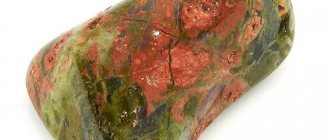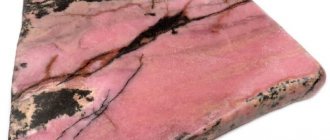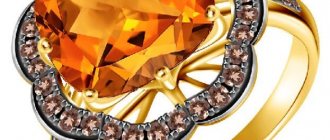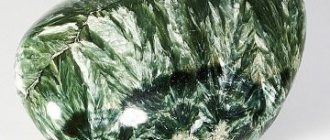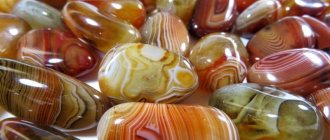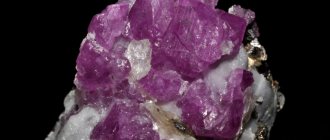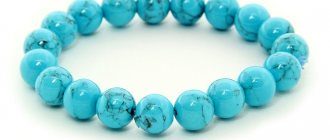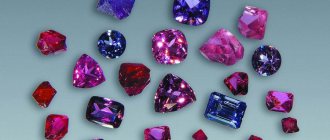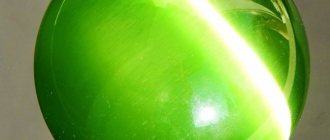| Category | Phosphates (minerals) |
| Title in English | Turquoise |
| Formula | CuAl6(PO4)4(OH)8 4H2O |
| Group | Turquoise group |
| Color | Blue, Green, Gray |
| Stroke color | Blue |
| Shine | Glass, Frosted |
| Transparency | Opaque, Transparent, Translucent |
| singonia | Triclinic |
| Hardness | 5 — 6 |
| Cleavage | Perfect/imperfect |
| Density, g/cm³ | 2,6 — 2,8 |
| Kink | Conchoidal |
| origin of name | The name of the oldest mineral, turquoise, comes from the Persian word firuze, which translates as “stone of happiness.” Also, there is a variant in which they use piruz, which means “the one who wins.” According to another version, the word turquoise was formed from the French Turquie - translated as “Turkish”. This is due to the fact that the first turquoise came to Europe through Turkey. By the way, because of this, turquoise is often called “Turkish”. |
| Morphology | Turquoise has rare crystals of a short plasmatic appearance with characteristic large facets. |
Turquoise is a gem of extraordinary beauty and properties. Even its main color is so incomparable that it was called turquoise. It is interesting that man has encountered this mineral throughout his history. All ancient peoples used turquoise in one way or another. And today the stone remains extremely popular, convenient for making jewelry and inexpensive. Over the thousand-year history of use, most deposits of turquoise have not been depleted and it is still being mined all over the globe. What can we say about the various magical and healing properties of the gem. In the world of precious stones, turquoise is a real miracle.
Turquoise deposits
Turquoise is a popular and valuable gem with numerous deposits.
However, its deposits are usually small, and therefore production becomes quite expensive. — Advertising —
Turquoise deposits in the Sinai Peninsula began to be mined around 6000 BC. e. By now, all of them have been almost completely depleted and are not suitable for industrial work, but locals continue to extract stone by hand.
Most of our natural turquoise today comes from large copper deposits as a by-product. This is done in the USA, as well as in Egypt, Iran, Afghanistan, Armenia, Tajikistan, Uzbekistan, Turkmenistan, Tanzania, Australia, and Argentina.
This is interesting
- Esotericists say that green turquoise has less magical properties than all other representatives.
- Archaeologists managed to find a mummy 8,000 years old. On her hand was a gold bracelet decorated with turquoise.
- In ancient times in Iran, the mineral was more expensive than the precious metal - gold.
- The tiara of Farah Pahlavi, the Empress of Iran, is decorated with the largest examples. Now the masterpiece of jewelry art is kept in the Shah's treasury.
- The Aztecs considered the gem to be the tears of the Sky Goddess. They believed that the samples would bring them love and happiness.
- In one of the Aztec burials, more than 50 thousand items decorated with gems were found.
- Followers of Buddhist teachings consider the mineral sacred. According to legend, he helped the supreme deity defeat the monster.
- The peoples living in the Caucasus always decorated their brides' clothes with turquoise. They believed that this would protect the girl from the evil eye.
- Ancient Russian warriors took turquoise items with them on military campaigns. They became amulets for them.
History of turquoise
The name turquoise comes from the ancient Farsi language.
The Persians used the term “firyuza” to mean a good mood, pleasure, and a bud that had just opened its petals. "Piruz" was translated as "victory." And, according to the Persians, turquoise helped them cope with their enemies. The Arabs borrowed both the gem and its name from the Persians, and used it to attract good luck. Moreover, the stone entered into Islamic traditions: it was on turquoise that the legend of the Prophet Muhammad was engraved.
— Advertising —
Buddhists valued turquoise as it was believed that it helped the Buddha deal with a demon.
Turquoise came to Europe through Turkey, which is reflected in its French name “pierre turquoise” or “Turkish stone”. It was also called heavenly stone and Egyptian blue. It was believed that turquoise appears from the skeletons of dead righteous people and helps sinners to take the right path, and turns green if they do not correct themselves. And cavalrymen wore rings with turquoise, because they believed that it reduced the weight of the rider and prevented injuries when falling from a horse.
Russian legends say that turquoise is found where a person died who suffered from unrequited love. For this reason, girls were not given jewelry with this mineral.
And even the North American Indians knew turquoise. In their traditions, there was a Sky goddess who cried tears from this stone. The pieces found were highly valued and used as money.
Who will benefit from the stone?
Turquoise activates female sexuality; it will help single women attract fans and find love. It endows men with charisma, and is suitable for those who are seriously pursuing a career or struggling for power.
Advertising - Continued below
However, whatever your goals, it is worth considering that turquoise helps only highly moral and ethical individuals; it does not tolerate deception and meanness. In the worst case, the stone can even turn against the owner if his thoughts are unclean.
Physico-chemical characteristics of turquoise
According to its chemical composition, turquoise is a phosphorus salt of copper and aluminum.
Its crystals are bright blue or greenish, opaque. The color palette of the mineral also contains apple and dark green, gray-green, olive, brown, whitish shades, which are often combined on the surface of one stone. Hardness on the Mohs scale 5-6. Specific gravity 2.8 g/cm3.
Turquoise is usually found as cryptocrystalline kidney-shaped, nodular, non-translucent aggregates or veins.
Photo and appearance
The stone is found in nature in different varieties. Samples are often represented by crusts, veins, and cryptocrystalline masses. The surface of the rock is usually pierced by brown or black veins .
Do you already have such a stone?
Rare translucent blue variants are classified as gemstones. Such a sample has a high price on the jewelry market.
Treated turquoise is a very beautiful stone. The color can vary from light blue to almost green.
Types of turquoise
According to their appearance, stones are distinguished as brightly colored in blue-blue, blue, greenish-blue and green shades and pale blue and greenish-blue.
In addition, there are mesh (gossamer) and lace turquoise. The mesh pattern is formed by thin intersecting veins of manganese and iron oxides, or it is obtained by combining turquoise and black carbon slate (this phenomenon is also called matrix or mother turquoise). Lace turquoise is a subtype of matrix turquoise. It is painted in light colors and has complex patterns.
Artificial production of mineral
It is obtained by the reaction of malachite, aqueous alumina oxide and phosphoric acid at 100°. Imitation turquoise was made by compressing or fusing precipitated aluminum phosphate and copper phosphate; also by coloring chalcedony or other materials and glass. The imitation can be reliably determined using an X-ray diffraction pattern of the powder. Melting heat detection and flame coloration can also be used for this purpose. Natural turquoise that is not of good enough color is sometimes subjected to artificial processing to give it the desired shade.
“Artificial turquoise” of many varieties has been produced for about a century. So, in the 19th century. in Austria (in Vienna), and then in France and Great Britain, the so-called “Viennese turquoise” was obtained by pressing aluminum phosphate tinted with copper oleate. The refractive index of “Viennese turquoise” is 1.45; when heated in the flame of a gas burner, it sinteres into black glass, while natural turquoise turns into a dark brown powder. “Neolith” - an imitation of reticulated natural turquoise - was obtained in 1957 in Germany. It is a mixture of beyerite Ca (BiO)2 (CO3) 3 and copper phosphate, impregnated with artificial resins. Dark veins were created by impurities of amorphous Fe compounds. There are imitations obtained by pressing dihydrated aluminum phosphate with copper phosphate, Al(OH)3, Cu(SO4), etc.
Turquoise records. Tajikistan
Magical properties of turquoise
Turquoise attracts financial well-being to its owner, increases intuition, and also gives courage, foresight, and insight.
One of its main properties is considered to be the ability to establish peace, prevent and settle quarrels and scandals. Thanks to this, the gem has a good effect on the microclimate in the family and the relationships of friends.
Blue turquoise is a source of energy for its owner. If it turns pale or green, this indicates an illness in the owner. Turquoise in green shades is recommended to be worn only by adults. Stones of other shades are used as protective amulets for children.
Talismans with turquoise bring victories, good luck, protect from troubles and endow the owner with invulnerability. They are often taken on trips to make them safe. And hunters attach turquoise to their guns to accurately hit the target.
Heavenly stone for people
Every country where azure stone appeared used it for “eye candy.” These were, of course, decorations, inlays, decoration of weapons, horse harnesses. Eye-pleasing azure adorns the mosques of Persian architecture and the magnificent Taj Mahal.
Cutting and polishing turquoise in Nishapur, Iran, 1973
In South America, ritual objects were decorated with turquoise. Ceremonial masks from the skulls of defeated enemies were covered with pieces of turquoise.
A tiara with diamonds and emeralds was prepared for the second wife of Napoleon I (Marie Louise). The capricious empress ordered the green stones to be taken out and replaced with turquoise.
From Turkish to azure spar
What is turquoise called:
- azure spar;
- ferize (Persian “stone of happiness”);
- piruz (Persian winner);
- agaphyte;
- Aztec stone;
- Arabic stone;
- callait.
International name turquoise. The azure stone was delivered to Europe from Turkey and through this country, hence the name.
In Russia the stone was called “Turkish”.
Medicinal properties of turquoise
Turquoise is recommended for insomnia and nightmares.
It has a positive effect on the functioning of the cardiovascular and respiratory systems, and the gastrointestinal tract. It sharpens vision, relieves headaches, helps treat colds, and helps restore skin. It has also been noted to have a good effect on the condition of the vocal cords and thyroid gland. It is believed that if an amulet with turquoise is worn in a pendant, it will help stop bleeding and treat stomach ulcers. With age, turquoise changes color from light blue to bright and rich, then to greenish blue and green. It is bright blue turquoise that is given the greatest healing power. And any changes in its shade directly indicate changes in the owner’s health.
What do we see on the shelves?
Let's look at turquoise in detail:
| Natural – Natural turquoise | A pure gift from the earth. This is pristine, natural turquoise. It was extracted from the rock, cut, and sold. You will have to look for such turquoise (there is very little of it), although it is expensive |
| Cemented (strengthened) - Stabilized turquoise | Also natural, but impregnated with resins, oils, wax and other substances to reduce the porosity of the stone. Sellers will not tell you that this is “tweaked” turquoise. Although she is natural... |
| Natural refined – Color-Treated turquoise | It is made from high-grade raw materials. And beautification is a simple painting of stones. It not only gives bright color, but also strengthens the stone. |
| Pressed, Reconstituted turquoise | It is also called restored. Made from turquoise chips (waste from the work of jewelers and craftsmen). They also add “substandard” stones - stones unsuitable for jewelry processing. All this is mixed, crushed, fastened with special adhesives-cements and pressed into blocks. The blocks are used to make jewelry. |
Raw turquoise, Nevada, USA. Raw nuggets from the McGuinness Mine, Austin. Blue and green web cabochons, Bunker Hill Mine, Royston
Expert opinion
Semenishcheva Polina
Specialist in mineralogy. Graduated from St. Petersburg Mining University.
FYI : Jewelry is mostly made from pressed turquoise. It is more durable, brighter, shiny than natural.
Industries where turquoise is used
Turquoise is widely used in jewelry and as an ornamental stone.
It is processed into cabochon or made into plates. High-quality specimens are easily sanded and polished and retain their color for a long time. They are used to make beads, bracelets, rings, pendants, and earrings. If the turquoise is of low quality, then the product can be lubricated with resin or wax to add depth and shine to its matte surface, increase water resistance and strength.
Diagnostic signs
Similar minerals. Lapis lazuli.
Diagnostics of the mineral is very difficult due not only to the presence of synthetic and refined stones, but also to the use of a huge number of imitations. Since ancient times, odontolite, also known as “bone turquoise,” has been passed off as turquoise. It represents the fossilized remains of teeth and bones of various animals containing apatite and vivianite, which determine its grayish-blue or light blue color. The hardness of odontolite is 5, the density is slightly higher than that of turquoise - from 3.0 to 3.25 g/cm3, the average refractive index is from 1.57 to 1.63. There is an odontolite deposit in France. It can be distinguished by its characteristic bone pattern observed under a microscope. In addition, odontolite usually contains some amount of calcium carbonate, and therefore reacts with HCl with a hissing effect. Under the name “Australian turquoise” or “Australian jade” it is widely used as an imitation of turquoise variscite Al [PO4] • 2H2O rhombic system; hardness - 3.5-5; cleavage perfect at {010}; density 2.2-2.61 g/cm3; ng = 1.570—1.594; nm = 1.565–1.584, np = 1.550–1.563, ng–np = 0.010–0.031; inert in ultraviolet rays). Chrysocola CuSiO3 •2H2O can be distinguished from turquoise by its lower hardness values of 2 to 4, density and refractive indices.
Minerals such as lazulite, hemimorphite, shattuckite, prosopite, hualite, amazonite, colored howlite and chalcedony, as well as artificial materials: enamels, plastics, glass, ceramics, porcelain, earthenware can be used as imitations. The latter are distinguished by hardness, density, and the presence of small bubbles.
Associated minerals. Limonite, chalcedony, kaolin.
Turquoise colors
Turquoise is characterized by such an unusual shade that it got its name - turquoise, since it was extremely difficult to choose an option among those that already existed.
However, different subspecies of turquoise may differ in color characteristics. The color palette of the gem begins with a sky blue tone and continues all the way to rich green. The blueness is determined by the admixture of copper, and the green tint comes from inclusions of iron compounds. Very often in natural stones you can see many dark veins and dots, from which beautiful original patterns are formed. Turquoise can change color when exposed to high temperature, sunlight, human sweat, oils, cosmetics, household chemicals, and when dried.
This is important to consider both when caring for the stone and taking into account the fact that the sweat of a sick person can release substances that affect the color of the mineral. Therefore, the fact that turquoise reacts to the health status of its owner is not just a coincidence.
Chemical and physical properties
This is a rather fragile stone. Luminescence (glow) is absent, but may occur in some samples. The mineral is characterized by a dull, waxy luster. Turquoise does not sparkle or shine.
When heated, cracks form on the gem. The mineral dissolves completely in hydrochloric acid. Turquoise does not like moisture. All discovered deposits were in dry places.
The chemical composition is not constant. May have changed during the aging process of the mineral. Calcium, strontium, zinc, iron oxide and other elements are present. “Rust” spots on turquoise are iron oxide, white inclusions are provided by an admixture of kaolinite and wavellite.
How to distinguish real turquoise from a fake
Natural blue-green minerals, such as chrysocolla with quartz, variscite and blue-tinted howlite, can be confused with turquoise.
Sometimes they are used in fakes of natural stone. Even the ancient Egyptians learned to counterfeit turquoise. For this purpose, colored glass, porcelain, and bones soaked in copper salts were used.
Modern artificial turquoise is made from copper aluminophosphates, ceramics and plastics with coloring impurities. Only an expert can distinguish them.
Mineral care
Owners should adhere to the following recommendations:
- The stone does not like the sun; it is forbidden to leave it in direct rays.
- Do not use alcohol when cleaning products.
- You can use mild soap solutions.
- Turquoise is a fragile mineral and cannot withstand impacts.
Compliance with the rules of care will extend the life of the talisman and preserve the beauty and attractiveness of the miraculous mineral.
How to care for turquoise
Turquoise and jewelry with it require a very gentle and attentive attitude.
Since the gem easily deteriorates when exposed to chemicals, jewelry is removed when preparing and cleaning, or when applying cosmetics. Turquoise products are cleaned exclusively with clean water or special products. They are not dried in the sun and are not left for a long time. Store in tightly closed boxes.
Origin
Turquoise is formed during low-temperature hydrothermal processes. This mainly occurs when copper-bearing waters come into contact with alumina and apatite. Moreover, turquoise prefers dry and hot climates.
Expert opinion
Semenishcheva Polina
Specialist in mineralogy. Graduated from St. Petersburg Mining University.
Sometimes Aztec stone is formed from fossilized animal bones. This is odontolite, bone turquoise. It is not easy to find it on sale, but “turquoise bones” are found in Siberia.
Interesting facts about turquoise:
- Turquoise was very highly valued in Ancient Egypt. Sacred scarab beetles were carved from it and served as amulets and cult objects. The Egyptians mined turquoise in the arid deserts of the Sinai Peninsula. Pharaoh sent many thousands of captives and slaves to these difficult jobs.
- Interestingly, turquoise was no less popular on the other side of the Atlantic Ocean. The Aztecs made ritual masks from it, which have survived to this day.
- At all times, turquoise has been considered a symbol of health, happiness and good luck. It is recognized as the stone of daredevils and brave men, a conductor of higher powers, and warriors in ancient times decorated the hilts of their swords with this mineral in order to become invincible.
Turquoise and zodiac signs
The properties of turquoise vary, and according to the zodiac sign, the stone suits people to varying degrees.
Change
| Best shade | Sign | Characteristic |
| Blue | Sagittarius | It will help in all new projects, improve relationships with your loved one or close friend. |
| Aquarius | It will make the owner wiser, help build relationships with loved ones, and speed up the meeting with your soulmate. | |
| Twins | Will teach you to find harmony between the physical and spiritual principles. | |
| Green | Scorpion | It will allow you to find the best solution in a short time, even in emergency conditions, and will give you the strength to turn long-standing plans into reality. |
| Taurus | It will increase self-esteem and protect from ill-wishers. | |
| White | Fish | It will relieve you from anxious thoughts and teach you how to avoid conflicts. |
| Aries | Will inspire you to new achievements that will improve your financial condition and recognition in the team. | |
| Virgo | It will protect you from damage and false gossip, and teach you to better understand the people around you. | |
| Gray-blue | Cancer | Develop hidden talents and increase the chances of getting the desired position. |
| Scales | It will increase self-confidence and help identify liars among new business partners. | |
| Capricorn | It will teach you how to use energy rationally and correctly set priorities in life, which will help you avoid many conflicts. |
What stones does turquoise make friends with?
Minerals are like people—they welcome some of their neighbors, are indifferent to others, and can’t stand others. Let's see what preferences turquoise has.
| Compatibility (combination) of stones | Minerals |
| Very good | aquamarine, agate, lapis lazuli, carnelian, crystal, tourmaline, topaz. |
| Neutral | diamond, amethyst, zircon, ruby. |
| Bad | alexandrite, jasper, peridot, hematite, aventurine. |
If you are hoping for magical or healing help from turcus, make sure that it is adjacent to a friendly mineral.
Varieties
The type of turquoise depends on the admixtures of other elements and age. A gemstone containing a large amount of iron, for example, is called Raschleite. There is aluminochalcosiderite - the closest relative, copper phosphate. But the easiest way to distinguish firuza is by age, since color also depends on age. It is worth noting that if you do not heat it too much, it will gradually begin to change its color. This occurs due to loss of moisture. They are also distinguished by the place where it was mined - for example, Iranian blue, Tibetan green, Arizona blue.
Different shades of blue
The magic of azure spar
Since ancient times, merchants from the East tried to have a ring with a blue stone. After all, they all knew the eastern proverb “the hand that wears a turquoise ring will not become scarce.” On long journeys, people tried to take with them an amulet or jewelry made of a lucky stone. He drove away dangers and dashing people along the way.
Pendant with turquoise
For male warriors, it was important to decorate the hilts of their swords with pieces of turkus in order to be invincible in battle. On the harness of horses in rich burials, inserts of a heavenly-colored mineral are found.
But the main magical property of turquoise is to reconcile enmity, restore peace in the family, stop scandals, and subdue anger.
The best amulet for children is a piece of turquoise. The wise East has known about this for a long time, and they tried to place a piece of a lucky stone at the head of every newborn.
The magic of a gem set in silver will help you find love.
The pebble can bring prosperity to the owner (you won’t become an oligarch, but life will be easier). But only turquoise in combination with gold brings prosperity.
For people prone to frequent outbursts of anger, it is useful to have jewelry made of a lucky stone. It will help its owner control his emotional state.
Ring with turquoise
It has long been noticed that the turquoise of a sick owner becomes ill (changes color, becomes dull). However, don’t worry right away—for a short time, the sensitive mineral temporarily loses its luster before bad weather.
You should not wear jewelry with azure spar every day. Limit yourself to two to three days a week.
It is worth remembering that the energy of a lucky stone is hostile to evil and malicious people. Those who do not follow moral commandments. The stone will bring misfortune to such people.
We recommend: MERGEL - breadwinner, builder
And the stolen stone will fully demonstrate its negative properties.
It is important to know: the magical properties of the mineral will only work in natural stone. Counterfeits do not have magical properties.
Who suits the name
Female names that suit turquoise:
- Ustinya;
- Lolita;
- Stephanie;
- Galina;
- Asol;
- Anna;
- Evgenia;
- Svetlana;
- Olga;
- Tatiana.
Men's:
- Andrey;
- Oleg;
- Alexander;
- Matvey;
- Adam;
- Novel;
- Maksim;
- Stanislav.
